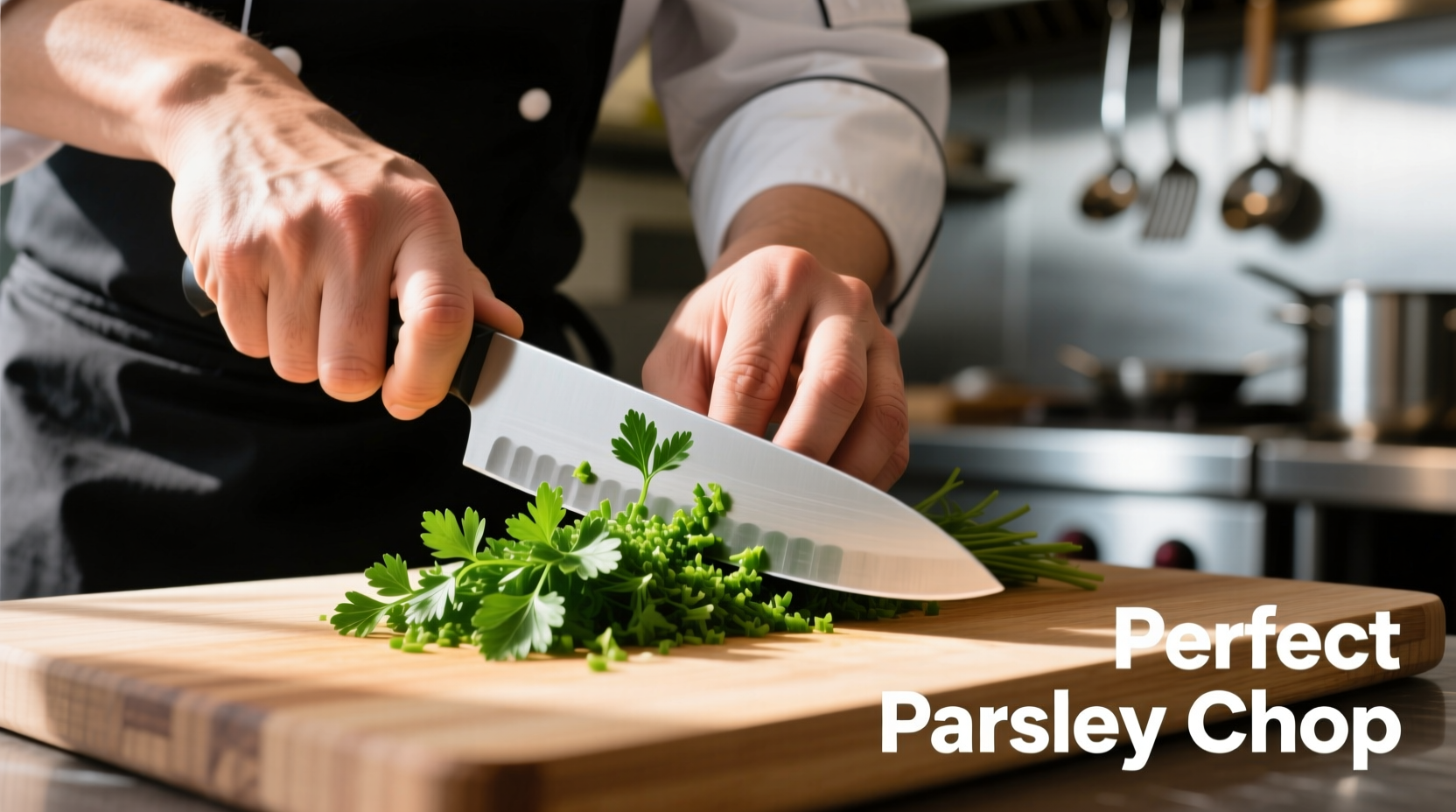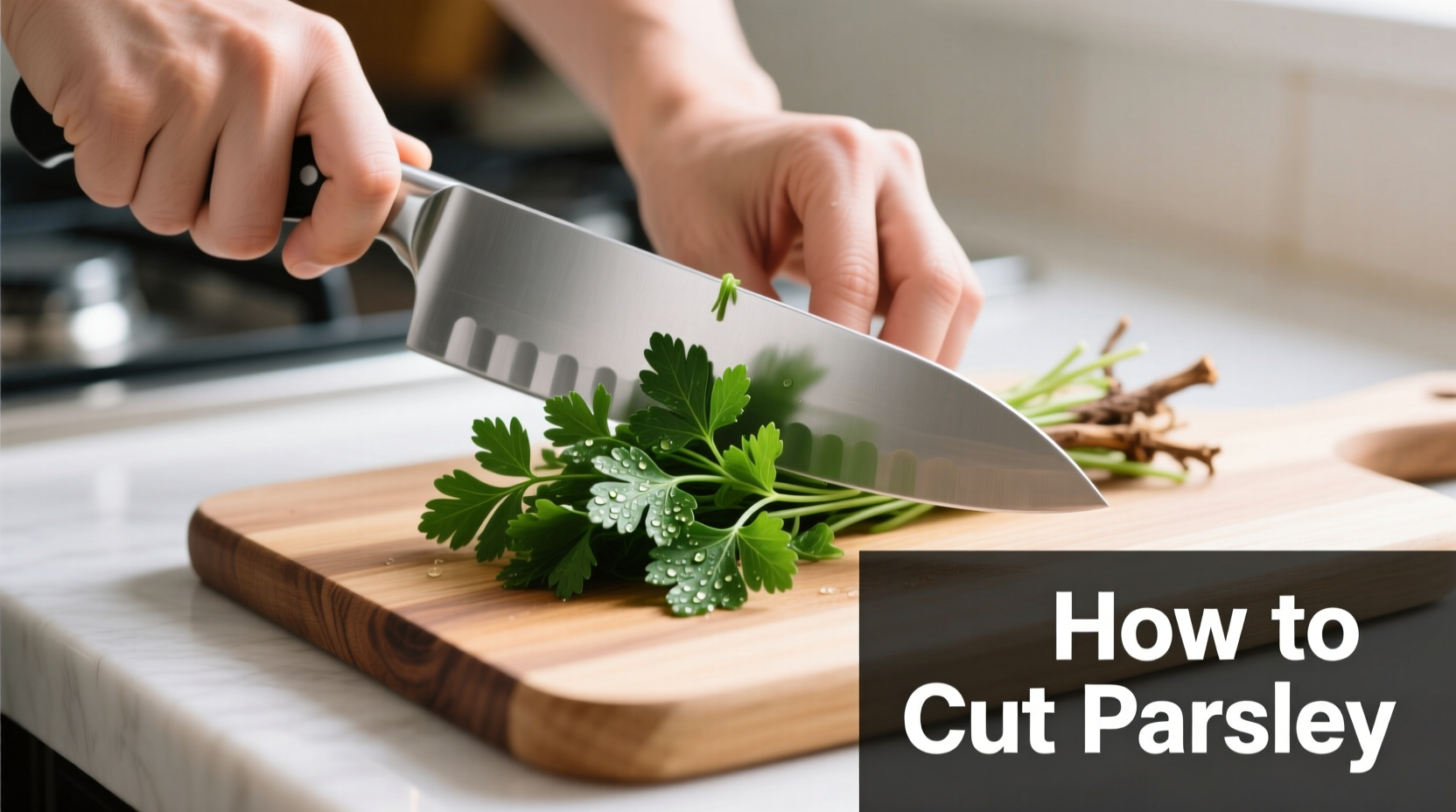Mastering parsley preparation transforms your cooking from amateur to professional level. Unlike many home cooks who roughly tear or haphazardly chop this essential herb, the right cutting technique maximizes flavor release while maintaining vibrant color and texture. Whether you're garnishing a finished dish or incorporating parsley into sauces, soups, or salads, proper cutting makes a noticeable difference in both appearance and taste.
Essential Tools for Cutting Parsley
Before you begin, gather these kitchen essentials:
- Sharp chef's knife (8-10 inches)
- Cutting board (wood or plastic)
- Salad spinner or clean kitchen towels
- Small bowl for finished parsley
Professional chefs emphasize that knife sharpness is non-negotiable. A dull blade crushes parsley stems instead of cutting them cleanly, releasing bitter compounds and causing rapid oxidation. According to the Culinary Institute of America's knife skills guidelines, properly maintained knives should cut through paper with minimal pressure.

Step-by-Step Parsley Cutting Process
Follow these professional steps for perfect parsley every time:
1. Preparation: Washing and Drying
Immerse parsley in cold water for 2-3 minutes to remove dirt and debris. Gently swish the bunch to dislodge any trapped particles. Transfer to a salad spinner and spin thoroughly dry. If you don't have a spinner, lay the parsley on clean kitchen towels and pat gently—never rub, as this damages delicate leaves.
Moisture is parsley's enemy when cutting. The University of California Cooperative Extension food safety guidelines emphasize that wet herbs lead to bacterial growth and faster spoilage. Proper drying extends freshness by up to 50% compared to improperly dried herbs.
2. Stem Separation
Hold the parsley bunch firmly at the stem ends. Using your other hand, pinch the leafy portion and pull upward to separate leaves from tough lower stems. Discard thick lower stems but retain thinner upper stems which contain concentrated flavor compounds.
3. The Professional Cutting Technique
Gather the parsley leaves into a compact mound on your cutting board. Place your non-knife hand in the 'claw grip' position over the herbs, fingertips curled under for safety. Using a rocking motion with your chef's knife, make swift, even cuts through the entire bundle.
For fine mincing, rotate the pile 90 degrees and repeat the cutting motion. Never saw back and forth—this bruises the parsley and releases bitter juices. The American Culinary Federation recommends maintaining consistent pressure and speed for optimal results.
| Cutting Style | Best For | Cutting Technique |
|---|---|---|
| Coarse Chop | Stews, braises, stocks | ¼-inch pieces, include some tender stems |
| Medium Chop | Sauces, dressings, meat dishes | ⅛-inch pieces, mostly leaves |
| Finely Minced | Garnishes, compound butters, delicate sauces | 1/16-inch pieces, rotate pile between cuts |
| Chiffonade | Salads, pasta garnishes | Stack leaves, roll tightly, slice crosswise |
Contextual Cutting: When to Use Different Techniques
The appropriate cutting method depends entirely on your culinary application. Understanding these context boundaries prevents common mistakes that compromise your dishes:
- For raw applications (garnishes, salads, chimichurri): Use fine mincing to distribute flavor evenly without overwhelming bites
- For cooked dishes (soups, stews, braises): Coarser cuts maintain texture through long cooking times
- For delicate sauces (beurre blanc, hollandaise): Ultra-fine mincing ensures smooth texture
- For compound butters: Medium-fine chop creates ideal flavor distribution
Chef Thomas Keller's Ad Hoc at Home cookbook notes that improper parsley cutting ranks among the top five mistakes home cooks make with fresh herbs. When parsley pieces are inconsistent in size, some overcook while others remain raw, creating uneven flavor distribution.
Avoid These Common Parsley Cutting Mistakes
Even experienced home cooks frequently make these errors that diminish parsley's quality:
- Using a food processor: Creates uneven, bruised results and heats the herbs through friction
- Cutting while wet: Causes parsley to darken rapidly and develop off-flavors
- Using a serrated knife: Tears rather than cuts the delicate leaves
- Over-handling: Excessive touching transfers skin oils that accelerate spoilage
- Cutting too far in advance: Prepared parsley loses 40% of its volatile flavor compounds within 30 minutes
Proper Storage of Cut Parsley
Maximize freshness with these storage techniques:
- Line an airtight container with slightly damp paper towels
- Add cut parsley in a single layer (don't pack tightly)
- Cover with additional damp paper towel
- Store in the refrigerator's high-humidity drawer
- Use within 24-48 hours for optimal flavor
Research from the Journal of Food Science shows that properly stored cut parsley maintains 85% of its essential oils for up to 48 hours, compared to just 60% when stored improperly. For longer storage, freeze chopped parsley in olive oil cubes—a technique favored by professional kitchens.
Advanced Technique: Preserving Parsley's Volatile Oils
For maximum flavor impact, professional chefs employ this advanced method:
After cutting, immediately place parsley in a small bowl and drizzle with a few drops of high-quality olive oil. Gently toss to coat—this creates a protective barrier around the cut surfaces, slowing oxidation. The oil also helps capture and distribute the herb's volatile flavor compounds throughout your dish.
This technique, documented in Harold McGee's On Food and Cooking, leverages the solubility of parsley's essential oils in fat, ensuring more consistent flavor distribution in finished dishes.











 浙公网安备
33010002000092号
浙公网安备
33010002000092号 浙B2-20120091-4
浙B2-20120091-4